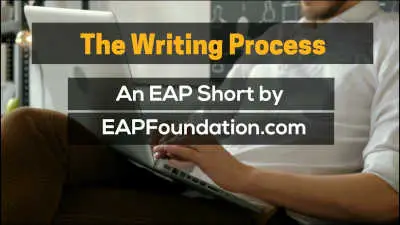Show AWL words on this page.
Show sorted lists of these words.


 







|
The first stage of the writing process is to understand the title. This is a key stage. Get this wrong, and your whole essay may be worthless, meaning hours of wasted time. A common complaint by course tutors is that their students do not answer the question. By taking the time to understand the title, you can be more confident that the content of your essay or report will be relevant, which will earn you a higher grade. It will also ensure that your background reading, if it is a researched assignment with references, will be more focused. The most important aspects of understanding the question are identifying the key words and the command words in the title. Both of these are considered below.
Key words
The first thing to do when looking at the title is to underline the key words. Some of these may need defining in your answer. Pay special attention to command words (see below), which give you a clear indication of how to answer the question. Read through the question several times to make sure you understand exactly what it is asking. If it is a researched assignment, rather than an exam essay, you may also want to discuss the question with your tutor to make sure you completely understand it.
Command words
Command words, also called directive words or instruction words, are words (usually verbs) in the title which tell you exactly what you need to write in your answer. Below are some of the most common command words and their meaning.
| Command word | Meaning |
| Account for | Gives reasons for the subject of the question. Note: this is different from give an account of, which looks at 'what' rather than 'why'. |
| Analyse | Break an idea or issue into parts, looking at each one in depth and considering how they relate to one another. This type of answer needs to be very logically organised. |
| Assess | Weigh up how important something is, using evidence or reasoning. Conclude by saying how far you agree with the original question. |
| Clarify | Make something clearer, e.g. explaining a complex process or theory in simpler terms. |
| Comment upon | State the main points and give your opinion. |
| Compare | Identify the similarities and differences. The answer should be balanced, and may comment on which similarities or differences are more important. Note: technically, 'compare' means to show how things are similar, but in essay titles you are expected to look at both similarities and differences; some titles may make this more explicit by asking you to 'Compare and contrast...'. |
| Consider | Say what you think about the subject, using evidence from your own experience or from external sources. |
| Contrast | Similar to compare, but considers only the differences. |
| Criticise | Identify weaknesses or disadvantages, as well as favourable aspects. The answer should be balanced. |
| Define | Give a definition, i.e. the precise meaning. This answer may include problems with the definition and alternative definitions which may exist. |
| Demonstrate | Show how, using examples to illustrate your answer. |
| Describe | Say what something is like, how or why something works or happens, etc. |
| Discuss | Argue for and against, or point out the advantages and disadvantages, using evidence. You must argue both sides, and come to a conclusion. |
| Disprove | Look at the 'con' points (those against) to show why something is not true. Requires a logical answer with evidence. |
| Elaborate | To give more detail/information on the subject. |
| Elucidate | Make the subject clear (i.e. lucid) by explaining what it means. |
| Evaluate | Same as assess. Some questions use 'Critically evaluate', which means the same thing. |
| Examine | Look at the topic closely by establishing the important facts and issues. You should give reasons to say why you think those facts and issues are the most important ones. |
| Explain | Give a detailed explanation of how and why something occurs, or what is meant by a particular idea or principle. Will often require definition of key terms. |
| Explore | Consider a topic from different viewpoints. The topic should be explored thoroughly, and opposing views could be reconciled in the final argument. |
| Give an account of | Give a detailed description of something, i.e. explain 'what' it is. Note: this is different from account for, which looks at 'why'. |
| Identify | Show what the key points are, and what they imply. |
| Illustrate | Use examples or statistics to explain the subject of the question. |
| Interpret | Say what you think something means, in order to demonstrate your understanding. You may be asked to interpret terminology used by a writer or the findings from research. If you are interpreting findings, you should comment on patterns or causal relationships. |
| Justify | Give reasons for a position (e.g. 'Justify the use of corporal punishment in schools'). Try to include counter-arguments to make your reasons more balanced. |
| Outline | Same as summarise |
| Prove | Look at the 'pro' points (those in favour) to show why something is true. Requires a logical answer with evidence. |
| Review | Look thoroughly at a subject. An answer to this question will be critical and not just description. |
| Show how | Give the stages or factors which give rise to something. The answer should be presented in a logical order. |
| State | Give the relevant points. These points should be clear and brief; avoid long discussion. |
| Summarise | Sum up the main points, usually with brief or general examples. Do not give details. Often requires a short answer. |
| To what extent | Similar to 'Discuss', in that both sides of the argument will be presented, with evidence. This type of essay, however, may be less balanced, depending on what extent (or 'how far') you think the proposition is true. It is commonly used as an IELTS Task 2 essay question, usually in the phrase 'To what extent do you agree or disagree?' |
| Trace | Describe the stages (e.g. in the development of a theory, of a person's life, of a process) in a logical or chronological order. Usually found in historical questions. |
Checklist
Below is a checklist for this section.
| Item | OK? | Comments |
| I have identified the key words in the title and I know what these mean. | ||
| I have identified the command word(s) and I know what I have to write in my answer. |
References
Gillet, A. (2015) Understand the question Available from: http://www.uefap.com/writing/question/question.htm (Access date: 15 June, 2016).
University of Leicester (n.d.) Essay terms explained Available from: http://www2.le.ac.uk/offices/ld/resources/writing/writing-resources/essay-terms (Access date: 15 June, 2016).
University of Reading (n.d.) Planning and structuring your essay Available from: http://www.reading.ac.uk/internal/studyadvice/StudyResources/Essays/sta-planningessay.aspx#answering (Access date: 15 June, 2016).
Next section
Read about brainstorming for ideas in the next section.
Previous section
Go back to the previous section about the writing process.







